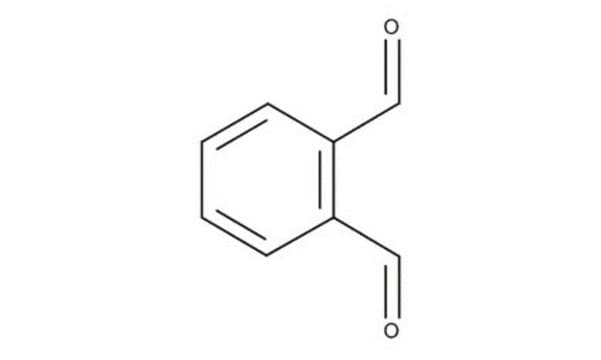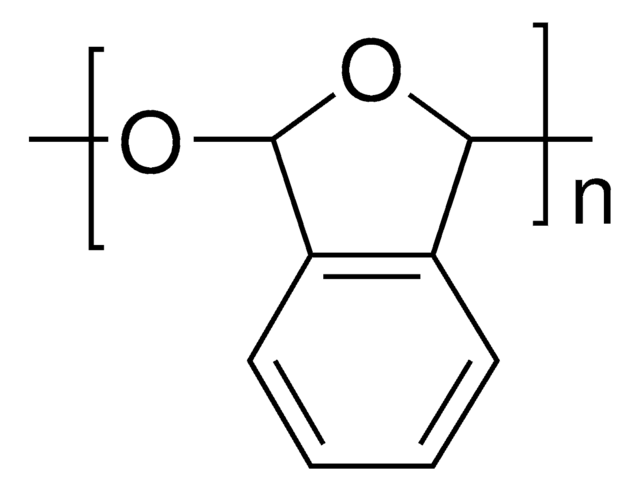If this product has an expiration or retest date, it will be shown on the Certificate of Analysis (COA, CofA). If there is no retest or expiration date listed on the product's COA, we do not have suitable stability data to determine a shelf life. For these products, the only date on the COA will be the release date; a retest, expiration, or use-by-date will not be displayed.
For all products, we recommend handling per defined conditions as printed in our product literature and website product descriptions. We recommend that products should be routinely inspected by customers to ensure they perform as expected.
For products without retest or expiration dates, our standard warranty of 1 year from the date of shipment is applicable.
For more information, please refer to the Product Dating Information document: https://www.sigmaaldrich.com/deepweb/assets/sigmaaldrich/marketing/global/documents/449/386/product-dating-information-mk.pdf
P1378
Phthaldialdehyde
≥97% (HPLC), powder or crystals
Synonym(s):
o-Phthalaldehyde, o-Phthalic dicarboxaldehyde, Benzene-1,2-dicarboxaldehyde, OPA
About This Item
Recommended Products
Quality Level
Assay
≥97% (HPLC)
form
powder or crystals
color
white to light yellow
mp
55-58 °C
storage temp.
2-8°C
SMILES string
O=Cc1ccccc1C=O
InChI
1S/C8H6O2/c9-5-7-3-1-2-4-8(7)6-10/h1-6H
InChI key
ZWLUXSQADUDCSB-UHFFFAOYSA-N
Looking for similar products? Visit Product Comparison Guide
Related Categories
Application
- to detect Arg through spectrophotometry using end-point fluorescent sensitive detection
- as a reagent stream with the sample to produce a fluorescent product for determining ammonia in seawater
- in the o-phthaldialdehyde spectrophotometric assay (OPA test) to determine the proteolytic activity (PA)of the strains and the commercial cultures
Biochem/physiol Actions
Signal Word
Danger
Hazard Statements
Precautionary Statements
Hazard Classifications
Acute Tox. 3 Oral - Aquatic Acute 1 - Aquatic Chronic 1 - Eye Dam. 1 - Skin Corr. 1B - Skin Sens. 1 - STOT SE 3
Target Organs
Respiratory system
Storage Class Code
6.1A - Combustible acute toxic Cat. 1 and 2 / very toxic hazardous materials
WGK
WGK 3
Flash Point(F)
269.6 °F - closed cup
Flash Point(C)
132 °C - closed cup
Personal Protective Equipment
Choose from one of the most recent versions:
Already Own This Product?
Find documentation for the products that you have recently purchased in the Document Library.
Customers Also Viewed
-
How can I determine the shelf life / expiration / retest date of this product?
1 answer-
Helpful?
-
-
How is shipping temperature determined? And how is it related to the product storage temperature?
1 answer-
Products may be shipped at a different temperature than the recommended long-term storage temperature. If the product quality is sensitive to short-term exposure to conditions other than the recommended long-term storage, it will be shipped on wet or dry-ice. If the product quality is NOT affected by short-term exposure to conditions other than the recommended long-term storage, it will be shipped at ambient temperature. As shipping routes are configured for minimum transit times, shipping at ambient temperature helps control shipping costs for our customers. For more information, please refer to the Storage and Transport Conditions document: https://www.sigmaaldrich.com/deepweb/assets/sigmaaldrich/marketing/global/documents/316/622/storage-transport-conditions-mk.pdf
Helpful?
-
-
Is Ortho phthaldehyde HPLC purity of >99% or >97% good enough for use an analytical grade reagent ?
1 answer-
This product has a minimum purity specification of 98%. For analytical purposes, high purity product options are generally preferred. Product P0657, Phthaldialdehyde, offers a minimum purity of 99% and is tested for suitability in fluorometric HPLC.
Please see the link below to review this product option:
https://www.sigmaaldrich.com/product/sial/p0657Helpful?
-
-
Has pthaldialdehyde been used to fix tissue and/or cells, and if so, what was the concentration?
1 answer-
The primary use of P1378 is for assaying amines or sulfhydryls in solution. It does not appear to be used as a fixative, although there are reports of its use as a high-level disinfectant. Phthalaldehyde is commonly used as a high-level disinfectant for medical instruments, typically sold under the brand names of Cidex OPA or TD-8. However, in the case of Phthalaldehyde, its use appears to be as a disinfectant rather than as a fixative. The product is tested for appearance, HPLC for purity, color, solubility, and for carbon content. No suitability testing is performed for any specific use.
Helpful?
-
Active Filters
Our team of scientists has experience in all areas of research including Life Science, Material Science, Chemical Synthesis, Chromatography, Analytical and many others.
Contact Technical Service













